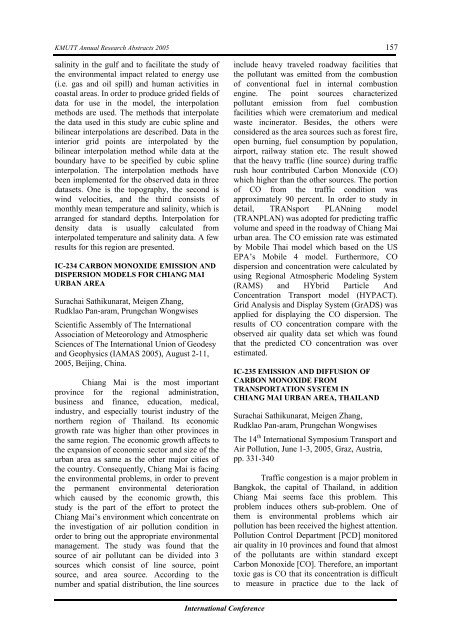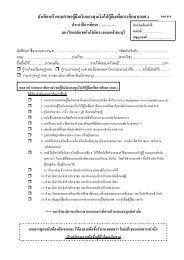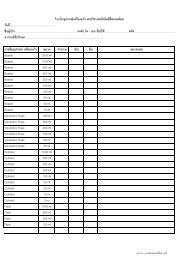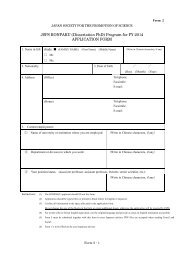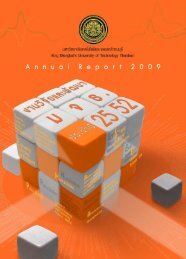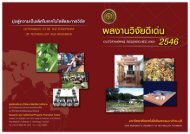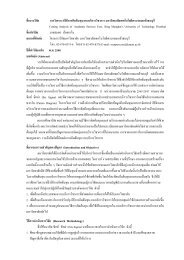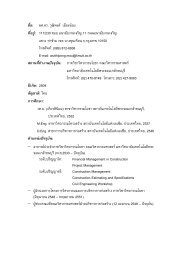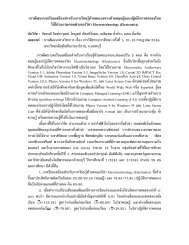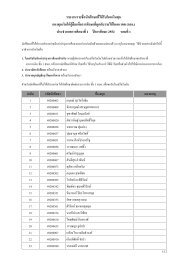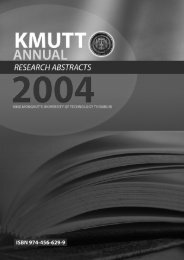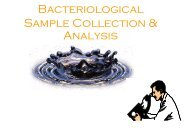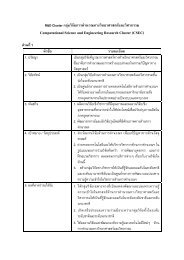You also want an ePaper? Increase the reach of your titles
YUMPU automatically turns print PDFs into web optimized ePapers that Google loves.
KMUTT Annual Research Abstracts 2005<br />
salinity in the gulf and to facilitate the study of<br />
the environmental impact related to energy use<br />
(i.e. gas and oil spill) and human activities in<br />
coastal areas. In order to produce grided fields of<br />
data for use in the model, the interpolation<br />
methods are used. The methods that interpolate<br />
the data used in this study are cubic spline and<br />
bilinear interpolations are described. Data in the<br />
interior grid points are interpolated by the<br />
bilinear interpolation method while data at the<br />
boundary have to be specified by cubic spline<br />
interpolation. The interpolation methods have<br />
been implemented for the observed data in three<br />
datasets. One is the topography, the second is<br />
wind velocities, and the third consists of<br />
monthly mean temperature and salinity, which is<br />
arranged for standard depths. Interpolation for<br />
density data is usually calculated from<br />
interpolated temperature and salinity data. A few<br />
results for this region are presented.<br />
IC-234 CARBON MONOXIDE EMISSION AND<br />
DISPERSION MODELS FOR CHIANG MAI<br />
URBAN AREA<br />
Surachai Sathikunarat, Meigen Zhang,<br />
Rudklao Pan-aram, Prungchan Wongwises<br />
Scientific Assembly of The International<br />
Association of Meteorology and Atmospheric<br />
Sciences of The International Union of Geodesy<br />
and Geophysics (IAMAS 2005), August 2-11,<br />
2005, Beijing, China.<br />
Chiang Mai is the most important<br />
province for the regional administration,<br />
business and finance, education, medical,<br />
industry, and especially tourist industry of the<br />
northern region of Thailand. Its economic<br />
growth rate was higher than other provinces in<br />
the same region. The economic growth affects to<br />
the expansion of economic sector and size of the<br />
urban area as same as the other major cities of<br />
the country. Consequently, Chiang Mai is facing<br />
the environmental problems, in order to prevent<br />
the permanent environmental deterioration<br />
which caused by the economic growth, this<br />
study is the part of the effort to protect the<br />
Chiang Mai’s environment which concentrate on<br />
the investigation of air pollution condition in<br />
order to bring out the appropriate environmental<br />
management. The study was found that the<br />
source of air pollutant can be divided into 3<br />
sources which consist of line source, point<br />
source, and area source. According to the<br />
number and spatial distribution, the line sources<br />
157<br />
include heavy traveled roadway facilities that<br />
the pollutant was emitted from the combustion<br />
of conventional fuel in internal combustion<br />
engine. The point sources characterized<br />
pollutant emission from fuel combustion<br />
facilities which were crematorium and medical<br />
waste incinerator. Besides, the others were<br />
considered as the area sources such as forest fire,<br />
open burning, fuel consumption by population,<br />
airport, railway station etc. The result showed<br />
that the heavy traffic (line source) during traffic<br />
rush hour contributed Carbon Monoxide (CO)<br />
which higher than the other sources. The portion<br />
of CO from the traffic condition was<br />
approximately 90 percent. In order to study in<br />
detail, TRANsport PLANning model<br />
(TRANPLAN) was adopted for predicting traffic<br />
volume and speed in the roadway of Chiang Mai<br />
urban area. The CO emission rate was estimated<br />
by Mobile Thai model which based on the US<br />
EPA’s Mobile 4 model. Furthermore, CO<br />
dispersion and concentration were calculated by<br />
using Regional Atmospheric Modeling System<br />
(RAMS) and HYbrid Particle And<br />
Concentration Transport model (HYPACT).<br />
Grid Analysis and Display System (GrADS) was<br />
applied for displaying the CO dispersion. The<br />
results of CO concentration compare with the<br />
observed air quality data set which was found<br />
that the predicted CO concentration was over<br />
estimated.<br />
IC-235 EMISSION AND DIFFUSION OF<br />
CARBON MONOXIDE FROM<br />
TRANSPORTATION SYSTEM IN<br />
CHIANG MAI URBAN AREA, THAILAND<br />
Surachai Sathikunarat, Meigen Zhang,<br />
Rudklao Pan-aram, Prungchan Wongwises<br />
The 14 th International Symposium Transport and<br />
Air Pollution, June 1-3, 2005, Graz, Austria,<br />
pp. 331-340<br />
Traffic congestion is a major problem in<br />
Bangkok, the capital of Thailand, in addition<br />
Chiang Mai seems face this problem. This<br />
problem induces others sub-problem. One of<br />
them is environmental problems which air<br />
pollution has been received the highest attention.<br />
Pollution Control Department [PCD] monitored<br />
air quality in 10 provinces and found that almost<br />
of the pollutants are within standard except<br />
Carbon Monoxide [CO]. Therefore, an important<br />
toxic gas is CO that its concentration is difficult<br />
to measure in practice due to the lack of<br />
International Conference


